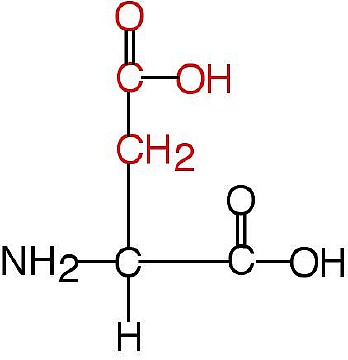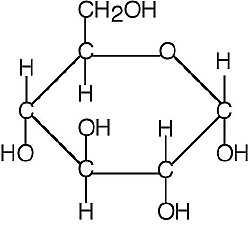Once the digestive system has enzymatically digested a protein in food so that it has been broken down to amino acids, the amino acids are absorbed into the villi (then the blood), as shown in a previous Video Clip.
The amino acids then travel in the blood to cells all over the body.
The next section describes what happens when an amino acid from a protein in food gets to a cell.
A. If there's NOT enough glucose available to the cell, the amino acid will be stripped of its nitrogen, which is excreted in urine. The image below is again the amino acid, aspartic acid.

Aspartic Acid
It is the liver that strips the nitrogen off and the kidney which puts it in urine for excretion. (That's why a baby's diaper smells like ammonia, which is NH3.)
Once the NH2 has been stripped off, the rest of it will be rearranged into glucose for use by brain, if needed.

Glucose
Once the NH2 has been stripped off, the rest of it will be rearranged into glucose for use by brain, if needed.

Glucose
If actual glucose isn't needed, it will be burned as fuel (it does not have to be turned into glucose to be burned as fuel).
- make a protein the cell needs, like tissue proteins, muscles or enzymes or it will be used
- make another amino acid the cell needs
- make other small nitrogen-containing compounds such as niacin
If none of those are needed, it would be rearranged and stored as fat.
C. If Carla has been following a high protein and low carbohydrate diet,
what would be happening is part
A.
(above). In other words, the amino groups in the amino acids of much of the protein she's eating would be split off and the remainder of the amino acid would be changed to glucose for the brain or burned as a fuel source. However, protein is still being used for part
B.
as well, but the majority of it would be burned for energy. The extra protein would only be stored as fat, if total Calories were also in excess. Typically with a high protein diet, there is less variety, so people tend to eat less Calories than they need, which means protein would not be stored as fat.
D. If Don has been eating a diet with plenty of foods with carbohydrate & protein,
what would be happening is part
B.
(above) In other words, the protein would be primarily used to supply amino acids to build body proteins. If he is consuming more calories than he needs, some protein would be changed to fat. With a diet that has plenty of carbohydrate, very little protein would be burned for energy part
A.
E.
The body can use either
liver
glycogen
or
muscle
protein
to make glucose for the brain. The body cannot change significant amounts of body fat into glucose for the brain, and muscles hoard their glycogen, they don't share with the brain.END OF LECTURE 6 A .
Now you're ready for 6 B .